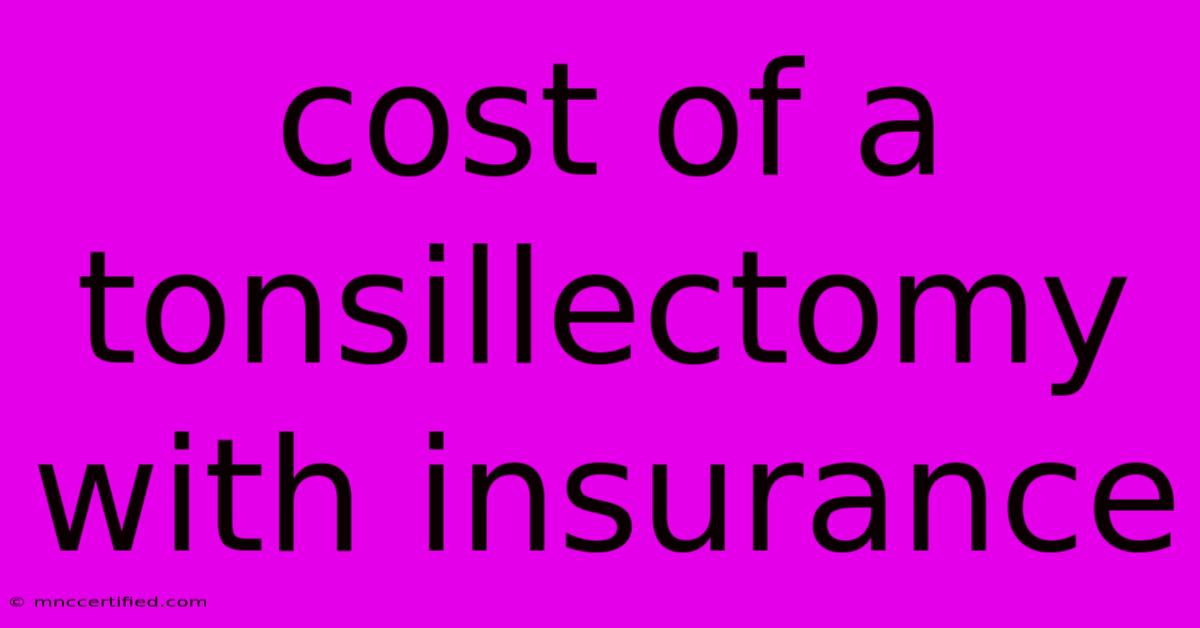Cost Of A Tonsillectomy With Insurance

Table of Contents
Understanding the Cost of a Tonsillectomy with Insurance
Tonsillectomy, the surgical removal of the tonsils, is a common procedure, particularly for children experiencing recurring tonsillitis. While it can offer significant relief, the cost of this surgery can be a significant concern for many families. This article will break down the factors influencing the cost of a tonsillectomy with insurance, providing a comprehensive understanding of what to expect.
Factors Affecting Tonsillectomy Costs
The cost of a tonsillectomy with insurance can vary greatly, influenced by several key factors:
1. Your Insurance Plan:
- Coverage: Your insurance plan's coverage for tonsillectomies is a primary determinant. Some plans may fully cover the procedure, while others may require copayments, deductibles, or coinsurance.
- Network Status: Out-of-network providers will likely result in higher costs compared to in-network providers.
- Pre-existing Conditions: Pre-existing conditions could affect coverage and overall costs.
2. The Surgical Method:
- Traditional Tonsillectomy: This involves removing the tonsils using a scalpel.
- Electrocautery Tonsillectomy: This method uses heat to remove the tonsils.
- Coblation Tonsillectomy: This method uses radiofrequency energy for tonsil removal.
- Laser Tonsillectomy: This technique utilizes a laser to remove the tonsils.
The specific method chosen can impact the cost, with newer techniques potentially being more expensive.
3. Anesthesia:
- General Anesthesia: This is the most common type used for tonsillectomies, requiring an anesthesiologist.
- Local Anesthesia: This is rarely used for tonsillectomies due to the potential for discomfort during surgery.
The type of anesthesia used will affect the overall cost.
4. Hospital or Surgical Center:
- Hospital: Hospital procedures generally come with higher costs due to overhead and staffing requirements.
- Ambulatory Surgical Center: These facilities typically offer lower costs compared to hospitals.
The location of the procedure can significantly impact its cost.
5. Post-Operative Care:
- Prescription Medications: Pain relievers, antibiotics, and other medications are necessary for post-operative recovery.
- Follow-up Appointments: Multiple follow-up appointments with the surgeon are often needed.
These post-operative costs can add to the overall expense.
6. Geographic Location:
- Urban vs. Rural: Surgical costs can vary depending on the geographic location, with urban areas generally experiencing higher costs.
This factor can affect the overall price tag.
Getting a Cost Estimate
To understand the specific costs involved in your situation, it's essential to:
- Contact your insurance provider: Discuss your coverage for tonsillectomies, including copayments, deductibles, and coinsurance.
- Reach out to potential surgeons: Request cost estimates for the procedure, including anesthesia, hospital fees, and post-operative care.
- Ask about payment plans: Explore payment plans or financing options available through the surgeon's office or hospital.
Tips for Managing Tonsillectomy Costs
- Consider your options: Compare costs between different surgeons and facilities.
- Shop around for medications: Obtain prescription medications at the lowest price possible.
- Ask about discounts: Inquire about any discounts offered by the surgeon or hospital.
- Utilize a Health Savings Account (HSA): If you have an HSA, you can use it to pay for qualified medical expenses.
Conclusion
The cost of a tonsillectomy with insurance is a complex issue, influenced by various factors. By understanding these factors and taking steps to manage costs, you can make informed decisions about this procedure. Remember to carefully review your insurance coverage, contact potential providers for cost estimates, and explore available payment options to ensure a financially sound approach.

Thank you for visiting our website wich cover about Cost Of A Tonsillectomy With Insurance. We hope the information provided has been useful to you. Feel free to contact us if you have any questions or need further assistance. See you next time and dont miss to bookmark.
Featured Posts
-
Warriors Vs Cavs Rivalry Renewed Nov 8
Nov 09, 2024
-
Dodge Charger Scat Pack Insurance Cost
Nov 09, 2024
-
Mc Donald S 1 Chicken Mc Nuggets Until December
Nov 09, 2024
-
How Much Is Insurance On A Rolls Royce
Nov 09, 2024
-
Candyman Star Tony Todd Passes Away At 69
Nov 09, 2024